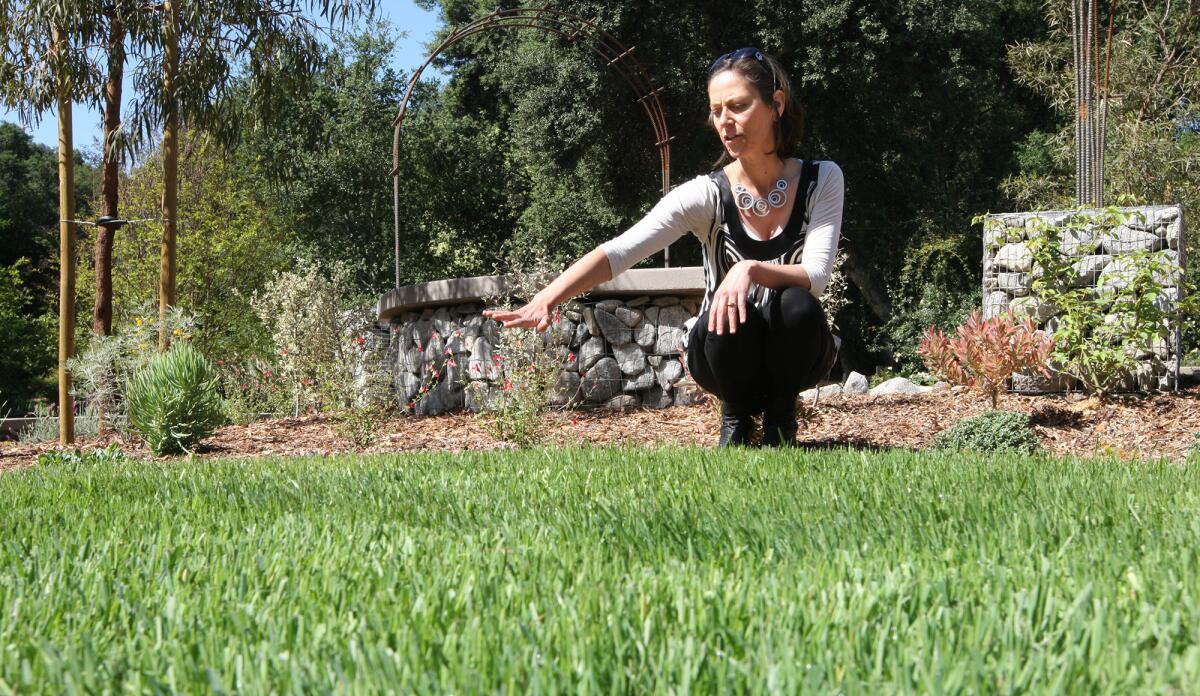New garden at Descanso shows La Cañadans how to reduce water for landscaping

When it comes to using water in a period of statewide drought, La Cañadans are going to have to pay to play.
That was the message handed down Tuesday by the State Water Control Resources Board, which determined communities grossly exceeding the California average of 77 gallons per person per day will be forced to make cuts beyond Gov. Jerry Brown’s recent 25% mandate, reducing their usage by as much as 35% in the coming months.
In cities like La Cañada Flintridge — where average daily water use in fiscal year 2013-14 topped out at a whopping 350 gallons per person, with 70% to 80% used for outdoor landscaping — the cuts are going to hurt, said Nina Jazmadarian, general manager of Foothill Municipal Water District.
PHOTOS: Descanso showcases “low-water” garden
“It’s a hefty amount,” Jazmadarian said of the penalties agencies could face for going beyond what Metropolitan Water District allocates to them, which would be passed on to residents. “We don’t want to pay that amount, and we don’t want our retail agencies and customers to pay that amount.”
For example, the current rate of $923 per acre-foot of water could increase to $2,043 if the agency goes 15% beyond the amount allocated to it, Jazmadarian estimated, with further overages racking up steeper penalties.
On Wednesday morning, a day after the state’s announcement, Descanso Gardens offered homeowners a note of encouragement in discouraging times, unveiling to members of the media a demonstration garden designed to recreate a “low-water” residential landscape.
The latest iteration of Descanso’s rotating Center Circle Garden, the new space showcases how lush and vibrant yards can still be while accommodating tighter water restrictions and a new environmental reality, said Rachel Young, Descanso’s director of horticulture and garden operations.
“We’ve been talking about water for a while now at Descanso,” said Young, explaining water reduction efforts made in the past five years. “After we started making changes here, we’re like, ‘Why aren’t we telling people about them?’”
Designed by Cassy Aoyagi, president of FormLA Landscaping and the Theodore Payne Foundation, the new garden presents a new look for Southern California landscaping at a time when maintaining lush, green lawns is becoming untenable, said David Brown, Descanso’s executive director.
In a brief history lesson, Brown traced the nation’s love of lawns back to 17th-century England, when rich landowners replaced utilitarian gardens with largely aesthetic, but useless, lawns as symbols of wealth and luxury. The practice migrated to America’s East Coast and, eventually, to California.
“The English aesthetic began to be introduced to Southern California in the beginning of the 20th century to entice families to come here,” Brown said. “It was a little patch of paradise.”
Today, however, residents need to reexamine their relationship with the plants they keep and the resources it takes to make it all happen, and Descanso officials are hopeful the new garden will inspire people to consider new, attractive alternatives.
The Center Circle Garden comprises 50% to 70% California native plants, with the rest made up of non-native low-water species. A conceptual front yard displays multiple drought-tolerant grasses that can be planted as seeds or sod, while benches with “gabion” bases, or cages filled with stones, allow for better water percolation into the soil, Young explained.
Richard Atwater, executive director of the Southern California Water Committee and a Descanso Gardens trustee, turned out Wednesday for the garden’s unveiling. He acknowledged its timing couldn’t have been any better.
“Obviously in California, it’s becoming a luxury to have water-thirsty lawns,” said Atwater, a La Cañada resident who replaced his own turf 15 years ago and can now boast a household per capita water use of just 50 gallons a day. “If everybody just had beautiful native landscapes, we’d be fine.”
Brown agreed, saying if La Cañadans opted for low-water landscaping and reduced their outdoor watering by half, they’d be well past the 35% reduction now being mandated by the state.
“You don’t have to do everything to do something,” he said. “(But) if everybody did something, we’d be in a better place.”
--
Sara Cardine, sara.cardine@latimes.com
Twitter: @SaraCardine
